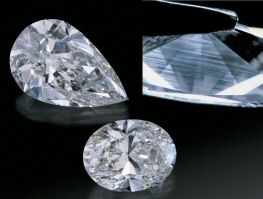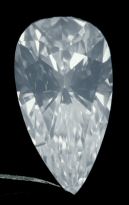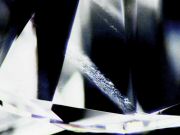Whitish or Reflective Graining in Diamonds: How GIA Evaluates Its Impact on Clarity Grading
March 29, 07
One of the most confusing and controversial aspects of diamond grading over the years has been the effect of internal whitish or reflective graining on clarity grades. It is confusing because graining is different from – and less quantifiable than – solid inclusions. It is controversial because of the impact such graining can have on the clarity grades of large, high-color, high-clarity diamonds, where the difference in a single grade – especially Flawless or Internally Flawless to VVS1 – can mean a difference of tens of thousands of dollars in the price of a stone.
In the Winter 2006 issue of Gems & Gemology, leading GIA Laboratory researchers – John M. King, technical director; Thomas M. Moses, senior vice president; and Wuyi Wang, manager of research projects – offer the most comprehensive look to date at internal whitish and reflective graining and how it affects clarity in the GIA Lab diamond grading process.
Briefly, there are three main categories of such graining:
- Banded “whitish” graining that appears as straight or wave-like lines in an otherwise very high clarity diamond. Sometimes these lines are crossed and appear woven in a “tatami-mat” pattern.
- Hazy whitish graining that comes from collections of submicroscopic particles; these give an overall haziness to the diamond.
- Reflective graining, which results when reflective lines appear as the stone is tilted in a certain direction. This and banded graining are caused by distortions in the diamond’s crystal structure that occurred during its formation and transport to the earth’s surface.
|
|
Because lab staff saw so few diamonds with these characteristics, reporting remained very general through most of the 1970s – diamonds that showed graining but had no inclusions were graded Fl or IF, with a note about reduced transparency. Toward the end of the decade, as lab staff and researchers saw more diamonds with whitish graining, GIA began considering it a clarity characteristic. For a time in the 1980s, they actually assessed the extent to which it was present, on a scale from nil to significant. Today, when such graining is severe enough to affect the clarity grade, a report comment notes that “The clarity grade is based on internal graining that is not shown [on the report diagram].” And significant graining, even when it doesn’t affect the clarity grade, is recorded in a report comment. All other graining observed is noted on internal GIA records for identification purposes.
|
|
First, unlike most clarity characteristics, visibility at 10× magnification is not the sole determining factor. Briefly, if a diamond does show whitish or reflective graining, then other factors, such as whether the graining can be seen from the crown or pavilion and its ease of visibility, come into play.
Obviously, lighting plays a key role in the examination, even to the point that GIA graders work in a room with subdued fluorescent ceiling lights that bring out natural dark/light contrasts within the diamond while keeping surface glare to a minimum and eliminating other extraneous light.
Graders locate the graining with a darkfield gemological microscope and then examine the diamond with a 10× loupe and the microscope’s overhead light.
The tricky part here is what’s called “viewing geometry.” Both whitish and reflective graining can be very subtle and elusive – like a hologram: Tilted one way the graining is quite visible; go to another angle and it disappears. To create a repeatable standard, graders hold the diamond a set distance from the lights and then angle it through a slight range of motion. If the graining is obvious in a single position but disappears with only a little movement, it probably will not affect the grade. Also, graining visible at an extreme angle is much less likely to affect a clarity grade than one visible straight through the crown or table.
|
|
|
|
The nature of the graining – how it affects transparency or how distinctly reflective it is – will also affect the grade. Whitish graining that is not well-defined and does not alter transparency probably would not cause an otherwise Fl or IF diamond to be downgraded. Nor would isolated bright internal grain lines. In rare cases where a whitish haze is visible through the crown, an otherwise Fl or IF diamond could ultimately receive a VVS, VS, or even – if the graining is extreme – an SI clarity grade.
|
|
Relief refers to how readily the grain lines or haze stand out from the surrounding diamond. Here, the impact is based not just on the graining’s visibility at 10× but also on the form and texture it takes. For example, a small “sheen” area that does not appear as bands may not affect the grade. However, if it takes the form of contrasting dark bands, the clarity grade may decline. And, again, if such characteristics are visible through the crown, the grade may be lowered further.
As with other GIA grading processes, years of research with a vast pool of stones has allowed the Laboratory staff to develop a consistent, repeatable standard for a characteristic that previously was not well-understood. Only after examining many hundreds of thousands of diamonds was the Lab able to assess the impact of whitish or reflective graining on the clarity grade of a colorless to near-colorless diamond.



